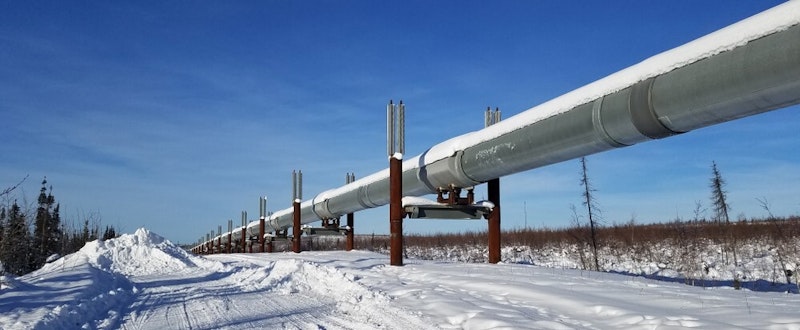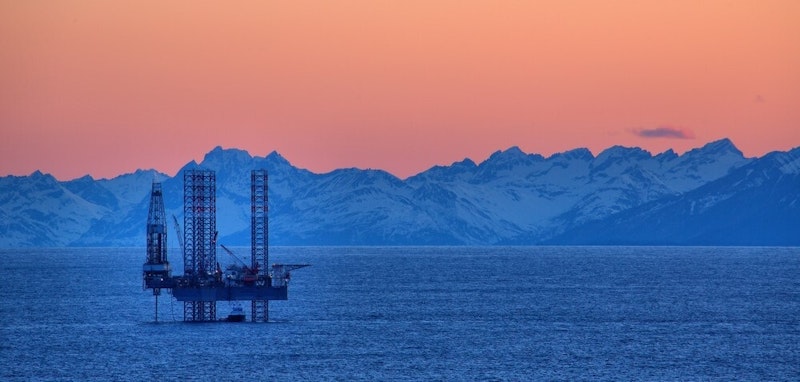Study Notes
GCSE Geography | Oil and Gas in Alaska (Cold Environments 7)
- Level:
- GCSE
- Board:
- AQA, Edexcel, OCR, Eduqas
Last updated 17 Oct 2024
Alaska has abundant supplies of oil and gas, both across the land, but also offshore in both the Beaufort Sea and the Arctic Ocean. The oil and gas industry is enormous in this region - it employs over 100,000, meaning that 1 in 7 Alaskans work in oil or gas, and generates around $US 50 billion annually - which is about a third of Alaska's income.
Onshore oil production
In the 1960s vast reserves of oil were discovered onshore close to the northern coast of Alaska, and oil production began in the late 1970s, producing around 2 million barrels a day. The 800km trans-Atlantic pipeline was constructed to transfer oil to the southern coast port of Valdez as ice in the northern seas meant that oil tankers couldn’t get close to the coastline. The pipeline was fairly complicated to construct - in the end it took five years and cost US$8 billion (which would be approximately $US34 billion today) - however at the time the USA was desperate to increase its own energy security because of rising oil prices and political problems.
It was a complicated project for several reasons...
Permafrost - this meant that the pipeline had to be raised off the ground and mounted on stilts (11m deep), so any heat from the pipeline wouldn't be able to melt the ground.
Major rivers - there are several that flow through Alaska, including the Yukon which is 700m wide in places, so suspension bridges were constructed for the pipeline so it could cross waterways.
Tectonic activity - Alaska is close to a plate margin and the Pacific Ring of Fire, so there is a risk of earthquakes. The pipeline zigzags in some areas so that it can be flexible and adjust to tectonic movement.

The benefits and costs of the oil and gas industry in Alaska
There are many benefits of oil and gas production in Alaska – it provides a huge amount of jobs and accounts for 90% of taxes raised in the state, so funds education, health, policing and important community services.
The trans-Alaskan pipeline was also extremely carefully planned to minimise the environmental impact - it goes through tundra land which is part of the caribou migration route so part of it has been placed underground to prevent disturbance to these animals. The pipeline is also extremely well insulated which prevents the permafrost below it from melting, but also prevents the oil from freezing, which could lead to pipes bursting.
However oil and gas production causes many issues for Alaska. Locals account for around 20% of the workers, the rest of the jobs are taken by migrant workers who tend to have short-term contracts and spend very little in the local area, which prevents the multiplier effect.
There are also serious environmental impacts - particularly the risk of oil spills. The most devastating oil spill in the region occurred in 1989 when the Exxon Valdez oil tanker ran aground on the southern Alaskan coast. 1.2 million barrels were spilled - with only 15% ever recovered, and the impact on wildlife was huge with around 5000 sea otters, seals and eagles dying. In 2006 a broken pipeline caused 1 million litres of oil to spill out over the North Slope region in Alaska - an ecologically sensitive area.
The future of onshore oil production in Alaska
In the 1980s Alaska produced a quarter of all US oil, however this has declined slightly and now Texas, New Mexico and North Dakota, along with the offshore area in the Gulf of Mexico produce more. Currently there are disagreements about the future of oil here - there are potentially up to 16 billion barrels of oil that can be exploited below Arctic National Wildlife Refuge (pictured below), which is home to polar bears and many other rare species. Many people want this oil to be drilled and exploited, but luckily the US Senate voted against this so at the moment the area is protected.

Offshore oil and gas production in Alaska
Oil exploration operations have discovered up to 30 billion barrels of oil and many trillions of cubic metres of gas below the Beaufort Sea and Arctic Ocean, which could be exploited, opening up thousands of job opportunities and generating billions of dollars for the Alaskan economy. However, there are areas where oil drilling is not allowed - such as the breeding grounds for bowhead whales. This is not actually to protect this species, but to protect the traditional hunting practices of Inupiat communities who are allowed to conduct carefully control whale hunts, as sharing whale meat is a important tribal tradition.
However, most of the waters are open to exploratory oil drilling by big oil TNCs to scope potential sites for production. Oil exploration is controversial here - traditional communities want to protect their cultural heritage and traditions, but at the same time they depend on the oil and gas industry for employment.

You might also like
Energy - the Gas Trade
Study Notes
Energy - the Oil Trade
Study Notes
Oil spill in Mauritius will cause long term damage
16th August 2020
Cold Environments | AQA GCSE Geography
Quizzes & Activities